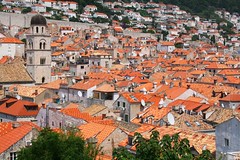The headings on my list of recommendations include traditional toy-making, a sea and sun-powered music and light show, ancient Greek fields, Roman marvels galore and stays in lighthouses on remote islands. Then there is the 1000 miles of crinkly coastline lined with rocky coves and pine-fringed beaches.
Glory restored
One US web site recently named Dubrovnik the third most romantic city in the world, after Buenos Aires and Bora Bora, but ahead of Paris and Venice. This handsome ”city of stone and light” between the Adriatic and the Dinaric Alps, was pounded during the Balkan war of the 1990s. Restorers pieced it together almost to the state of its glory days: the newer orange terra cotta tiles are the only real clues to where the bombs fell. The well preserved, mile-long 14th Century ramparts, are among the finest in Europe. The pedestrian-only old town within is full of outstanding Medieval, Renaissance and Baroque treasures, churches, monasteries and fountains, bell towers and gardens, as well as designer shops, restaurants and galleries. www.croatia.hr
Heart’s desire
The region of Istria stands apart at the very top of Croatia, a heart-shaped peninsula close to Trieste and Venice. Lonely Planet describes it on its list of top 2011 regions as “toned down Tuscany”. There are ma easy beach holiday options on Istria’s shore. (It’s the same all down Croatia’s long crinkly coast, and more than 1,000 islands.) Or you could escape to the region’s green interior, where narrow roads spiral up to remote fortified medieval hill towns and villages. Stay in a rural B&B and dine in restaurants under horse chestnut trees. Cycling holiday firms route you over well-signed paths, while they whisk your luggage to your next stop. This is prime truffle country: try them in omelettes or mixed into wild boar croquettes.
Nature’s show
Sea and the sun combine to give a virtuoso music and light performance on the promenade in Zadar, the pretty and historic town now served by budget flights. The Sea Organ is 35 pipes of different lengths, diameters and angles built into the steps over which the Adriatic washes. The tide pushes air down the tubes to produce a haunting and unpredictable symphony. Architect Nikola Basic has added Greeting to the Sun, a glass circle set on the quay at the exact point on the waterfront from where you see what is said to be the world’s most beautiful sunset. Photovoltaic plates (a type of solar panel) absorb energy by day and produce a show of dancing lights by night, and enough power to illuminate the entire quay. Zadar’s other attractions include boutique hotels, and Maraschino cherry liqueur.
Toy story
There is a heartwarming alternative to mass-produced, and you can find it in the region of Hrvatsko Zagorje, north of Zagreb. They’ve been making toys here by hand for ages, applying wonderfully simple skills that never died out. The men carve 50 types of toys from locally grown willow, lime, beech and maple, and the women decorate them in eco-friendly red, yellow and blue paint. UNESCO has put this admirable calling on its World Intangible Cultural Heritage List. The best villages to see toymakers in action are Laz Stubički, Laz Bistrički, Tugonica, Gornja Stubica, Turnišče and Marija Bistrica. Other Croatian traditions on the cultural heritage list are two-part folk singing in the coastal regions, and lacemaking in Pag, Lepoglava and Hvar.
Elysian fields
old, reason to take the short ferry trip from Split to sumptuous and magical Hvar, the longest of the Croatian islands. UNESCO recently declared the island’s Stari Grad Plain a world heritage site, recognising it as the best preserved ancient Greek landscape in the Mediterranean. Greek settlers started farming here 2400 years ago, and nothing has really changed in the quiet routine of cultivating grapes and olives, on the same parcels of land marked out by the original Greek surveyors. You can walk or cycle through this timeless horticultural grid, divided by ancient walls, dotted with beehive-shaped stone shelters. Another thing to do on Croatia’s islands is rent a lighthouse apartment.
Split–the difference
Croatia’s prodigious Roman remains are one of its many attractions. Split, with budget flights from the UK, and within an easy ferry journey from Italy, is a good short break location at any time of year. There’s the rare thrill of staying in a boutique hotel or apartment inside the 1,700 year old walls of Roman Emperor Diocletian’s vast palace. Thousands still live and work here, among the mediaeval architectural glories on a maze of marble pedestrian streets. Then dress your best and take a turn on the Riva, the promenade along the Adriatic to the pine-forested peninsula park. Just 20 miles away is another marvel, the outstandingly well preserved town of Trogir, with beautiful Venetian Renaissance buildings on a pre-Roman street plan.

